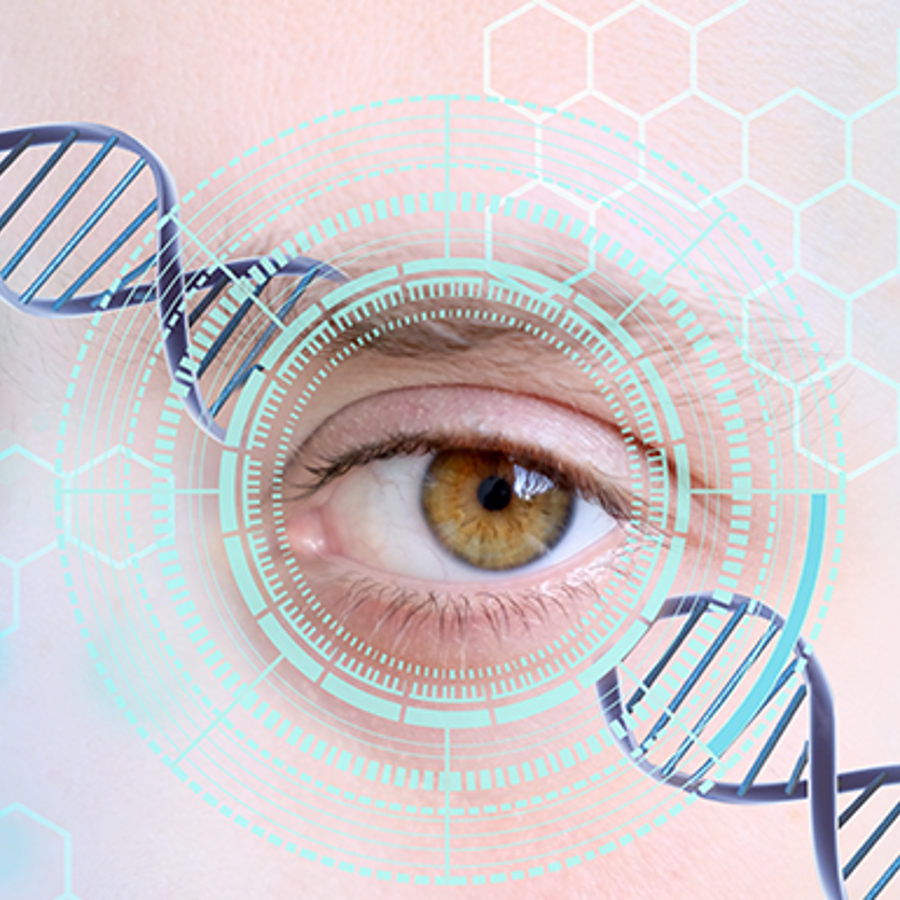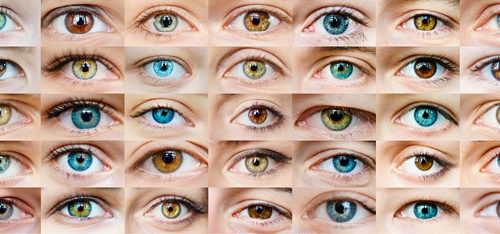
Why did 23andMe get my eye color wrong?
March 30, 2016

- Related Topics:
- Genotyping,
- Complex traits,
- Consumer genetic testing,
- Pigmentation traits,
- Eye color
A curious adult from California asks:
"I belong to 23andMe (DNA testing site) and have always wondered why it said I am more likely to have blue eyes. They use SNP: rs1393350 where I am a GG and rs12896399 where I am a TT. However, I have dark green eyes. Why do my SNPS that determine eye color basically say I should have had blue eyes when I clearly do not?"
You have hit on a big problem in this new genetic age. While we can easily take a peek at our DNA, we don’t always understand what it means.
See, the two spots that 23andMe looks at (those "SNPs" you mentioned) are a big deal in deciding between green and blue in people with non-brown eyes. But they are not the whole story. Many, many spots in your DNA play a role in determining your eye color.
So you have two SNPs that people with blue eyes often have. But as you show, just having those pieces of DNA isn’t a guarantee you’ll have blue eyes. Other places in your DNA that 23andMe doesn’t report on (or even know about) also matter.
To get at the why, we need to take a step back and talk about genes and how they affect each other. And how SNPs affect genes.
Genes are Instructions
Each gene has the instructions for one small part of us. We have over 20,000 of these genes. They control traits like eye color, height, and hair texture, to name just a few.
It helps to think of a gene as a recipe. The recipe spells out how to make a specific molecule in our body, which goes on to do a specific job. Often, many genes are responsible for spelling out the instructions for one trait, like eye color.
The gene, like a recipe, is literally a string of letters. But unlike a real recipe, the alphabet for genes is much simpler. There are only four possible letters in our genetic code: A, T, G and C.
Part of a gene might look something like this:
TAGCGTAGGACTGATGACCAATGATGACTAGATC
Now you’re probably thinking, why are we talking about genes? And what even is this “SNP” I keep mentioning?
A change in one specific spot in that string of letters is called a single nucleotide polymorphism, or SNP (pronounced “snip”).
Here is the sequence above again:
TAGCGTAGGACTGATGACCAATGATGACTAGATC
I have highlighted one of the letters. The letter G at that position would be considered a SNP. It just refers to a letter at a specific place or “address” in the genetic code. That’s called an rsID, which is how you describe them in your question.
Because all humans are different and unique, we all have differences in our genetic code. So some people might have a G at that position. Other people might have a T. Let’s take a look.
TAGCGTAGGACTTATGACCAATGATGACTAGATC
These differences are not a bad thing. They may or may not change the way the gene works in the body.
How SNPs Affect How a Gene Works
So how do we know that certain SNPs relate to different color eyes? Scientists can look for relationships between the letters someone has and the traits they have.
For instance, maybe they see that people with a G at that position usually have blue eyes. And maybe they see that people with a T at that position usually have brown eyes.
Very often we don’t know why a SNP causes a trait. We just know that people with that SNP for some reason have that trait.
But sometimes we do know. One example is having brown or not brown eyes.
We know that a gene called OCA2 has a big role in determining eye color. When OCA2 is going at full speed, it makes lots of a dark pigment that causes brown eyes.
We also know that a SNP in a nearby gene called HERC2 affects the amount of pigment the OCA2 gene can produce. A current idea is that in blue eyes, the SNP in HERC2 causes the OCA2 gene to stop making pigment in the eyes.
This makes a lot of sense as blue eyes happen when the eye does not make pigment in a certain part of the iris.
Interesting but what does this have to do with your SNPs? After all, the HERC2 SNP is not the one you asked about…

Genes Don’t Work in a Vacuum
As you know from perusing the 23andMe site, there is more than one SNP that affects eye color. And these SNPs can be in different genes.
All the genes that affect eye color aren’t just working by themselves. They can all affect each other too.
This makes it hard to make predictions even with known SNPs/genes. Throw in a bunch of unknown SNPs that can affect eye color too and you begin to see what we are up against with predicting even something as seemingly simple as eye color.
There could be a number of other SNPs that someone has that override others. Or other SNPs that influence more eye color genes. Or some other combination that scientists just haven’t figured out yet.
So when a company like 23andMe makes a guess at eye color, it’s just a prediction. They are doing the best they can with what is known.
But as more people get their DNA tested, scientists will get better and better at predicting which set of SNPs leads to which eye colors. There may come a time when predictions are much better.
We are not there yet. As scientists, we don’t completely understand what combination of genes causes blue eyes.
Right now, the best we can do is make a prediction based on the SNPs we know about. For now it will remain that, just a prediction.

Author: Chloe Reuter
When this answer was published in 2016, Chloe was a student in the Stanford MS Program in Human Genetics and Genetic Counseling. Chloe wrote this answer while participating in the Stanford at The Tech program.
 Skip Navigation
Skip Navigation
